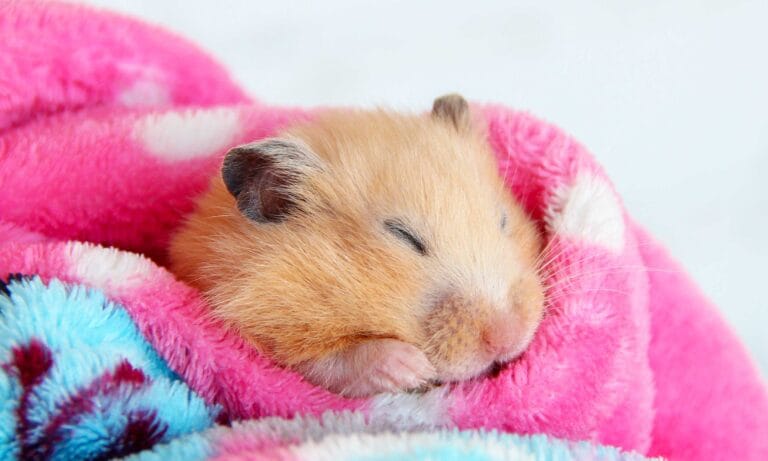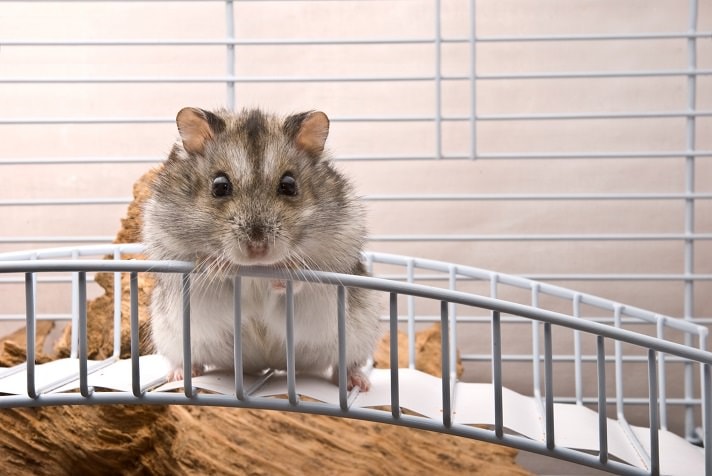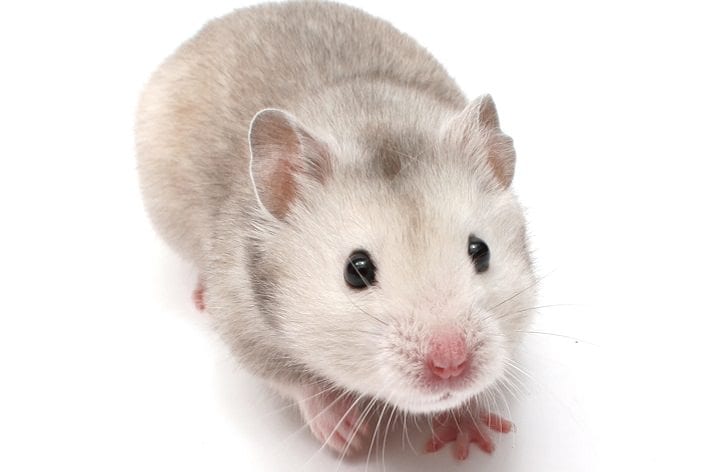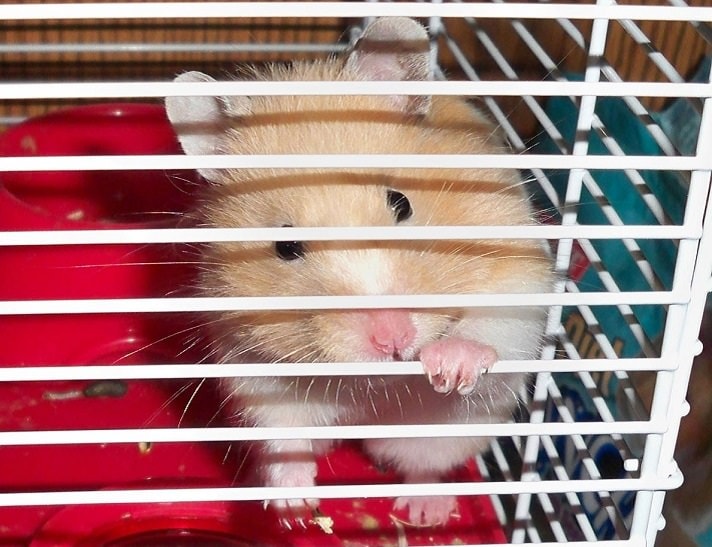Effectively communicating with your hamster doesn’t have to be a challenge. When you’re armed with the appropriate knowledge to get the job done, communication with your hamster can actually be easy.
1. “Slinky Operator” Hamster
A hamster slinking around its cage, acting quite a bit like a cat burglar isn’t in the midst of stealing anything, it’s simply trying to tell you that something is amiss.
“Often when in pain, a hamster may hunch his back slightly, and take very small steps,” says Dr. Kerry Kraemer, DVM, of Blum Animal Hospital in Chicago. “He may also be restless, and possibly show difficulties in getting comfortable. If you observe this type of movement, be sure to handle the hamster carefully, as pain may cause the animal to bite.”
2. “Wave Your Hands In The Air” Hamster
When curious, hamsters are known to explore the environment by standing on their hind legs and waving their front paws a bit. Hamsters do not have good eyesight, so they rely on other senses–such as touch, taste, scent–to grow accustomed to and explore their surroundings.
3. “I Can’t Get Up” Hamster
“Lethargy and reluctance to move indicate illness, and mean that it’s time to see a vet,” said Daniel Henry Johnson, DVM and owner of Avian and Exotic Care, P.A., in Raleigh, North Carolina.
4. “Burrowing Baby” Hamster
Hamsters burrow when sleeping, hiding food and retrieving previously hidden food. These three activities are completely normal and done regularly. Sleeping hamsters are easily startled if not woken up before they feel your touch. This can lead to a quick nip or bite.
5. “Hissy Fit” Hamster
“Hamsters hiss when they are frightened or aggressive,” says Dr. Jeffrey Jenkins, DVM and owner of Avian & Exotic Animal Hospital in San Diego. “This is a warning. Let your friend settle or be prepared for the consequences!”
Hissing, however, is not the only way that hamsters display fear. Oftentimes, hamsters take on a strange stance, dominated by flashing their teeth and lying motionless on the ground, to communicate that they are feeling fear.
6. “Pretty Please With A Pellet On Top” Hamster
At a time when your hamster stands on its hind legs with its front paws hanging limply it might appear to be begging, but actually it is being watchful. Watchfulness, in turn, can lead to aggression. And aggression can lead to a bite or a nip. A hamster may look sweet and cuddly in a begging stance, but keep your hands away from it at this time.
7. “Open Wide” Hamster
“A yawning hamster can be stressed or sleepy,” says Dr. Byron de la Navarre, DVM, and owner of Animal House of Chicago in Chicago. “Yawning can also indicate displacement behavior or an aggressive display. Yawning is often visible in aggressive, stressed and pre-sleeping hamsters. The best course of action when you see your hamster yawning is to leave him alone. Wait until the yawn is complete and assess the hamster’s body language before handling him.”
8. “Freeze Tag” Hamster
One thing that hamsters are absolute experts at is freezing. This involves your hamster staying in one position for a few minutes, its ears straight up and completely stiff to the touch. When a hamster takes part in “freeze tag,” it’s interested in something and has given its full attention to investigating it.
9. “Spa Day” Hamster
A hamster that spends time grooming itself thoroughly is at peace. The hamster feels calm, at ease and is in its element. Just as a human being doesn’t want to be interrupted in the middle of a massage, your hamster doesn’t want to be bothered while in the midst of a grooming session.
If you take notice of your hamster grooming suddenly, without prior indication of doing so, something may be amiss. A hamster that begins extensive grooming quite suddenly might be displaying fear. But fear isn’t the only possibility. “Hamsters normally groom themselves, but excessive grooming may indicate skin problems like parasites, or unclean fur, as occurs with diarrhea,” Johnson said. “A veterinarian should be consulted immediately.”
10. “Sniff, Sniff” Hamster
Hamsters engage in two different types of sniffing: a big, loud, deep sniff; and sniffing that is continuous. The continuous sniffing is a sign that a hamster is learning more about its current environment and is curious about its surroundings. This behavior most often takes place during exploration. The big, loud, deep sniff is quite similar to continuous sniffing, but has one major difference: it takes place when a hamster investigates a new location or place. This does not mean that a hamster will do a big, loud, deep sniff whenever it investigates its cage–quite the opposite.
A hamster is most likely to engage in big, loud, deep sniffs during exploration, when it encounters something unfamiliar, such as a tight passageway it cannot squeeze through. This sniff is a hamster’s way of learning more about this foreign place, even though it can’t physically explore it.
11. “The Grind” Hamster
“When a hamster grinds his teeth, it is very possible that this means that he is hungry and searching for food,” Dr. Kraemer says. “From a medical perspective, if teeth grinding–bruxism–is accompanied by drooling and a decrease in appetite or anorexia, this could be an indication of pain. One can carefully inspect a hamster’s incisors by scruffing the skin on the back of its neck to expose the incisors and check for damage, overgrowth or incomplete wear.”
12. “Nip Knowledge” Hamster
Nipping involves taking the skin of a human being between the teeth, and giving a gentle and quick pinch (generally on the hands). Hamsters, being fickle little creatures, might nip when they want attention, or when they are displaying annoyance.
Most often nipping takes place when a hamster is being held and wants to be put down so that it can play and explore. Nips also occur when a hamster that is resting and wants to be left alone gets disturbed. In either case, give the little hamster its way — you can always play with it at a later time.
13. “Lean Back” Hamster
Hamsters are very inquisitive animals. They are full of curiosity and constantly explore their surroundings. To do this, they typically keep their ears perked up and alert. Therefore, when you spot a hamster with its ears laid back against its head, it often means trouble.
14. “Species Behavior Differences” Hamster
Campbell’s, Winter White, Syrian, Roborovski and Chinese hamsters all possess almost identical behavioral characteristics. The two differences are that Chinese hamsters tend to be less easily stressed and Syrian hamsters must live alone once they reach maturity.
By: Erika Sorocco
Excerpt from the former annual magazine Critters USA, 2009 issue.
Featured Image: via AlexKalashnikov/iStock/Thinkstock
Share:









